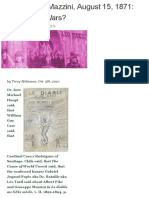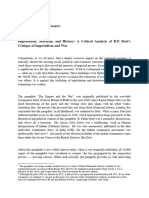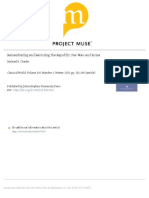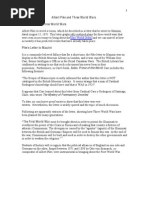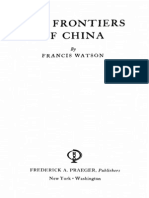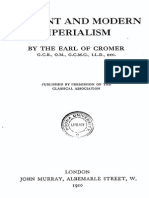SATIA-Time's Monster-REVIEW 1
SATIA-Time's Monster-REVIEW 1
Uploaded by
EnfantinCopyright:
Available Formats
SATIA-Time's Monster-REVIEW 1
SATIA-Time's Monster-REVIEW 1
Uploaded by
EnfantinOriginal Description:
Copyright
Available Formats
Share this document
Did you find this document useful?
Is this content inappropriate?
Copyright:
Available Formats
SATIA-Time's Monster-REVIEW 1
SATIA-Time's Monster-REVIEW 1
Uploaded by
EnfantinCopyright:
Available Formats
H-Diplo REVIEW ESSAY 331
1 April 2021
Priya Satia. Time’s Monster: How History Makes History. Cambridge: The Belknap Press of Harvard
University Press, 2020. ISBN: 9780674248373 (hardcover, $29.95).
https://hdiplo.org/to/E331
Editor: Diane Labrosse | Commissioning Editor: Lindsay Aqui | Production Editor: George Fujii
Review by Mircea Raianu, University of Maryland
Amid the ongoing turmoil of Brexit and the spectacular toppling of slave trader Edward Colston’s statue in Bristol in early
June 2020, a ‘third wave’ of debates on the historical legacy of the British Empire is arguably underway. The first broke out
in response to the Falklands War and the Raj nostalgia craze in the mid-1980s, while the second was catalyzed by the Iraq
War and Niall Ferguson’s controversial book and TV series Empire in the early 2000s. 1 These debates map onto
historiographical currents (such as the impact of Subaltern Studies and postcolonial theory) and institutional dynamics (in
particular the gulf between popular and professional historical writing). 2 Priya Satia’s sweeping new book sets the agenda for
the third wave. It is both urgently of its time, responding to the exigencies of the present political moment, and timeless in
its broader lessons about how to think about and do history.
Reflecting on the state of the field of imperial history a decade ago (in the wake of Iraq), Richard Drayton harshly
condemned academics’ complicity and proximity to power. “Historians enter into voluntary servitude to middle-class
opinion and taste…they are loyal to bureaucratic logics: both conservative toward the historical paradigms which organize
ideas of periodization and agency, and to the values of the social and economic order which produced them and in which
they so manifestly thrive.” Drayton’s proposed solution was a radical ethical reorientation at the individual level, or “taking
foreign pleasure and pain as one’s own.” 3 In a different vein, Jo Guldi and David Armitage’s History Manifesto lamented
historians’ marginalization and distance from centers of power. Their prescriptions included reviving the longue durée,
integrating big data, and actively influencing policymakers in order to counter the hegemony of economics and other social
sciences. 4 Satia neatly sidesteps these polemics, carefully reconstructing the discipline’s fraught trajectory from handmaiden
of the state to site of resistance. Time’s Monster echoes and amplifies Drayton’s concern with the subjectivity of the
individual historian. The book is after bigger epistemological fish, starting from the fundamental building block of historical
inquiry: the perception and ordering of time itself.
1
Niall Ferguson, Empire: How Britain Made the Modern World (London: Allen Lane, 2003). On Raj nostalgia, see Salman Rushdie, “Outside
the Whale,” Granta 11 (1984): 123-138.
2
Dane Kennedy, The Imperial History Wars: Debating the British Empire (London: Bloomsbury, 2018), chapter 9.
3
Richard Drayton, “Where Does the World Historian Write From? Objectivity, Moral Conscience and the Past and Present of Imperialism,”
Journal of Contemporary History 46:3 (2011): 673-674, 684-685.
4
Jo Guldi and David Armitage, The History Manifesto (Cambridge, UK: Cambridge University Press, 2014). A spirited debate ensued, with a
critique by Deborah Cohen and Peter Mandler and a reply by the authors. See “AHR Exchange: On The History Manifesto,” American Historical Review
120:2 (2015): 527-554.
© 2021 The Authors | CC BY-NC-ND 3.0 US
H-Diplo Review Essay 331
The main argument is most succinctly stated on pages 3-5, where Satia asks how a linear understanding of time came to be
deeply embedded in the rise of modern European (and specifically British) imperialism. Teleology served to absolve the
guilty consciences of empire’s makers and defenders, who often genuinely believed in the promises of progress. Put simply:
“How did such avowedly ‘good’ people live with doing bad things?” The answer lies in the mid-eighteenth century, when
history as a “system of ethical accountability” became central to Enlightenment notions of the self (14-15). Conscience, Page | 2
which was always situated in a temporal framework, structured the normative relationship between the individual and the
institutions of state and market. As Satia explains later in the book: “The Enlightenment goal of papering over internal
splits in the interest of producing internally coherent individuated selves had the effect of outsourcing judgments of
conscience to time, to history. It did not do so without struggle” (239).
In Chapter 1, Satia develops this argument by revisiting the Galton family of Birmingham, the subjects of her previous book
Empire of Guns. 5 For these “Quaker gun-makers,” commerce and warfare were inseparable and unavoidable, “necessary evils”
rendering individual ethical action meaningless. Yet the Galtons were also troubled by the blatant contradiction of
professing pacifism while profiteering from arms manufacture. By the end of the century, the abolitionist movement (in
which Quakers played a prominent role) empowered individuals to take action through consumer boycotts of slave-grown
sugar. But the system of “war capitalism” as a whole remained untouched (45-46). 6 Indeed, the arms trade as both the
material foundation of British power and an occasional focal point of public criticism is an interesting and original thread
running through the book (133, 153, 180). Also in the late eighteenth century, Member of Parliament Edmund Burke’s
prosecution of the East India Company’s abuses spotlighted the individual crimes of Governor-General Warren Hastings
while ultimately bolstering the legitimacy of the imperial enterprise (43). 7 In each instance, wrongs would be made right in
the fullness of time. If the answer to the injustice of slavery was free trade, the answer to the brutality of conquest was liberal
empire – a dynamic that played out repeatedly over the next two centuries.
Time’s Monster doubles as a focused intellectual history and a synthetic overview of the British Empire. Satia is equally
attentive to individual psychology, large-scale structural change, and the ebb and flow of ideas. The book plots out a dense,
interconnected web of people and texts (forming a “canon in dialogue with another,” 81), allowing the reader to see familiar
events with fresh eyes. Chapter 2 follows the consolidation of British rule in India from the Hastings trial to the 1857
Rebellion. The Romantic poetry of Lord Byron and the historical writings of James Mill, Thomas Macaulay, and Karl Marx
contributed to the sense of providential agency animating liberal imperialism. In parallel, a dissonant tradition of history as
exposé took shape. John Kaye’s History of the War in Afghanistan (1851) used “unofficial sources” to hold the imperial state
accountable for its military blunders but did not depart from the self-limiting model of scandalous revelation pioneered by
Burke (84-85). 8 In Chapter 3, Satia tracks the shift to indirect rule and racialized illiberal authoritarianism in the later
nineteenth century through the historical writings of Henry Maine, James Fitzjames Stephen, and J.R. Seeley. As the empire
became more bureaucratized, limits on individual agency provoked a new ethical and even spiritual crisis (139-140). These
two chapters deftly build on a venerable historiographical tradition about the “official mind” of imperialism, as well as on
more recent works diagnosing anxieties and tensions in the governing ideologies and everyday practices of the Raj. 9
5
Priya Satia, Empire of Guns: The Violent Making of the British Industrial Revolution (New York: Penguin, 2018).
6
On this concept, see Sven Beckert, Empire of Cotton: A Global History (New York: Alfred A. Knopf, 2014).
7
On the Hastings trial, see also Nicholas Dirks, The Scandal of Empire: India and the Creation of Imperial Britain (Cambridge: The Belknap
Press of Harvard University Press, 2006).
8
John William Kaye, History of the War in Afghanistan, 2 vols. (London: Richard Bentley, 1851).
9
See, in chronological order of publication, Ronald Robinson and John Gallagher with Alice Denny, Africa and the Victorians: The Official
Mind of Imperialism (London: Macmillan, 1961); Francis Hutchins, The Illusion of Permanence: British Imperialism in India (Princeton: Princeton
University Press, 1967); Thomas R. Metcalf, Ideologies of the Raj (Cambridge: Cambridge University Press, 1995); Karuna Mantena, Alibis of Empire:
Henry Maine and the Ends of Liberal Imperialism (Princeton: Princeton University Press, 2010); Jon A. Wilson, India Conquered: Britain’s Raj and the
© 2021 The Authors | CC BY-NC-ND 3.0 US
H-Diplo Review Essay 331
Chapter 4 revisits the cast of characters of another of Satia’s earlier books, her debut Spies in Arabia. 10 Espionage and air
control in the interwar Middle East created a “space of moral exceptionalism.” Figures like British Army officer and
adventurer T. E. Lawrence enacted Byronic fantasies of heroic agency, inspired by a complex and not always coherent
historical vision (Arabia as both a remnant of the deep Biblical past and a potential cure for the ails of British industrial
modernity). Yet the secrecy and violence of their exploits once again produced guilty consciences and divided selves (177- Page | 3
80). Paranoid fears of a widespread Bolshevik conspiracy around 1919-1920 recalled the panic about pan-Islamism in 1857
(174). Here Satia shows most clearly how the web of people and texts at the heart of the book constitutes a real kinship
network extending across time and space. Winston Churchill, who cut his teeth in colonial military service in the 1890s and
later directed the Royal Air Force aerial bombing campaign in Iraq in the 1920s as Secretary of State for Air, was guided by
his family lineage going back to the Duke of Marlborough (55-56). His successor Samuel Hoare descended from an
eighteenth-century Quaker banker we met in Chapter 1 (180). In calling attention to such resonances, Satia brilliantly
demonstrates how “an inherited sense of historic destiny, even entitlement, extends the life of great-man agency” (286).
Chapters 5 and 6 discuss the breakdown of the prevailing historicist logic of imperialism and explore alternative imaginaries.
Chapter 5 deals mainly with the Partition of India. The British sought to expiate their guilt and justify their ignominious
exit from the subcontinent by appealing to future judgments on the “balance sheet” of empire. This tendency may be seen at
a granular level in contemporary memoirs of civil servants like Penderel Moon, who was outwardly critical of the Raj yet
softened the blow by citing Marx’s dictum that Britain was “the unconscious tool of history” in India. 11 By contrast,
anticolonial thinkers like Mohandas K. Gandhi rejected stagist narratives in favor of a “present-oriented ethical vision”
(220). The strongest contribution of this chapter, and perhaps of the book as a whole, is to bring attention to the political
and ethical thought of Urdu poets like Muhammad Iqbal, Faiz Ahmed Faiz, Ali Sardar Jafri, and others. In grappling with
the trauma and dislocation of Partition, these literary figures drew on Sufi idioms of birha (longing) and notions of “split
selfhood” in South Asia to refuse “the linear teleology” of progress derived from the Enlightenment (227-237). The spatial
and temporal constraints of the world as it was could be transcended in the here and now – a heterotopic rather than a
utopic project. This argument breathes new life into a canon long siloed in the outer realms of area studies, hopefully
inspiring its (re)discovery by new audiences. However, the book could have done a bit more to historicize Urdu poetry itself
beyond and between the flashpoints of the 1857 Rebellion and the 1947 Partition.
Chapter 6 opens with another masterful illustration of kinship connections, tracing the intellectual arc of historian Edward
Palmer (E.P.) Thompson. His father Edward John Thompson wrote history as exposé, much like John Kaye, “cultivating a
passionate faith in the historian’s craft as the most effective means of truth-telling against the imperial state” (248-249). Yet
the son’s interests and commitments sharply diverged from the father’s, as E.P. devoted his energies to the domestic struggles
of the working classes in England. His scholarly output was marked by a seemingly deliberate forgetting of Britain’s and
India’s intertwined histories. E.P. as “historian-activist” was a product of decolonization yet never fully acknowledged his
debt to it (260-265). In this final chapter, the delicate balance between ideas and context becomes slightly skewed. Readers
would benefit from a deeper dive into the elder Thompson’s work, particularly The Rise and Fulfillment of British Rule in
Chaos of Empire (London: Simon and Schuster, 2016); Kim A. Wagner, Amritsar 1919: An Empire of Fear and the Making of a Massacre (New Haven: Yale
University Press, 2019).
10
Priya Satia, Spies in Arabia: The Great War and the Cultural Foundations of Britain’s Covert Empire in the Middle East (Oxford: Oxford
University Press, 2008).
11
Benjamin Zachariah, “Rewriting Imperial Mythologies: The Strange Case of Penderel Moon,” South Asia: Journal of South Asian Studies 21:2
(2001): 53-72. It is also on display in popular culture, which continues to draw on an unending reservoir of Raj nostalgia. Deepa Mehta’s film Viceroy’s
House (Pathé/BBC Films, 2017) recycles a fringe conspiracy theory attributing the Partition plan to secret geopolitical machinations between Churchill
and Muhammad Ali Jinnah’s Muslim League, all in order to absolve the Viceroy, Lord Mountbatten, for his responsibility in the breakdown of
negotiations. For incisive critiques of the film, see Fatima Bhutto, “I watched this servile pantomime and wept,” The Guardian, 3 March 2017,
https://www.theguardian.com/film/2017/mar/03/fatima-bhutto-viceroys-house-watched-servile-pantomime-and-wept; and Ian Jack, “The Viceroy’s
House version of India’s partition brings fake history to screen,” The Guardian, 18 March 2017,
https://www.theguardian.com/commentisfree/2017/mar/18/the-viceroys-house-version-of-indias-partition-brings-fake-history-to-screen.
© 2021 The Authors | CC BY-NC-ND 3.0 US
H-Diplo Review Essay 331
India (1934), as well as a more precise sketch of his relationships with his Indian interlocutors. 12 Similarly, Kaye’s histories
of the Afghan war and 1857 Rebellion could be examined in more detail in Chapter 2. What rhetorical strategies did these
texts use? How did they deploy sources and references, or traverse genre conventions? How were they circulated and
received? Of course, there is a risk of taking too many detours in a book of such ambition and scope. But a few strategically
placed sections dedicated to textual analysis would only serve to enrich the overall study.
Page | 4
For specialists, Time’s Monster will become an instant addition to syllabi and reading lists on the British Empire,
transnational and global history, and historical theory. In the latter realm it pairs nicely with Joan Scott’s newly published
On the Judgment of History, which advances a similar critique on the basis of a different set of case studies from Europe,
South Africa, and the United States. 13 For engaged scholars and the general public alike, Satia’s book will serve as an
invaluable resource in efforts to decolonize and reimagine the pursuit of knowledge in a world in crisis.
Mircea Raianu is Assistant Professor of History at the University of Maryland, College Park, with primary research interests
in modern South Asia and global capitalism. He is the author of the forthcoming book Tata: The Global Corporation that
Built Indian Capitalism (Cambridge: Harvard University Press, 2021).
12
Edward John Thompson and Geoffrey Garratt, Rise and Fulfillment of British Rule in India (London: Macmillan, 1934). The only detailed
study of this kind remains Sumit Sarkar, “Edward Thompson and India: The Other Side of the Medal,” in Writing Social History (Delhi: Oxford University
Press, 1997).
13
Joan W. Scott, On the Judgment of History (New York: Columbia University Press, 2020).
© 2021 The Authors | CC BY-NC-ND 3.0 US
You might also like
- CHRISTIANITY AS AN ARM OF EMPIRE: THE AMBIGUOUS CASE OF INDIA UNDER THE COMPANY, C. 1813-1858Document31 pagesCHRISTIANITY AS AN ARM OF EMPIRE: THE AMBIGUOUS CASE OF INDIA UNDER THE COMPANY, C. 1813-1858chhandak.pradhanNo ratings yet
- Imperial nostalgia: How the British conquered themselvesFrom EverandImperial nostalgia: How the British conquered themselvesRating: 4.5 out of 5 stars4.5/5 (2)
- Australia Looks To America The Wartime Relationship, 1939-1942Document22 pagesAustralia Looks To America The Wartime Relationship, 1939-1942Lorenzo FabriziNo ratings yet
- three concepts of tyranny in western medieval political thhoughtDocument23 pagesthree concepts of tyranny in western medieval political thhoughtAriadna SousaNo ratings yet
- App 4Document20 pagesApp 4Tommaso GazzoloNo ratings yet
- Philliou Ottoman Empire PDFDocument25 pagesPhilliou Ottoman Empire PDFDenis50% (2)
- Empire BanksDocument17 pagesEmpire BanksRobert ToynbeeNo ratings yet
- The Johns Hopkins University Press, Classical Association of The Atlantic States The Classical WorldDocument24 pagesThe Johns Hopkins University Press, Classical Association of The Atlantic States The Classical WorldAgatha GeorgescuNo ratings yet
- Empires in World History Power and The PDocument5 pagesEmpires in World History Power and The PBapt GntNo ratings yet
- Rule of Darkness: British Literature and Imperialism, 1830–1914From EverandRule of Darkness: British Literature and Imperialism, 1830–1914No ratings yet
- 671 FullDocument15 pages671 Fullثمرین شہبازNo ratings yet
- Scott Nelson - Who Put Their Capitalism in My SlaveryDocument23 pagesScott Nelson - Who Put Their Capitalism in My SlaveryfabisharaNo ratings yet
- Bell, Duncan - Victorian Visions of Global Order. Empire and International Relations in Nineteenth-Century Political ThoughtDocument316 pagesBell, Duncan - Victorian Visions of Global Order. Empire and International Relations in Nineteenth-Century Political ThoughtDavid Francisco Puertas100% (1)
- Albert Pike To Mazzini, August 15, 1871 - Three World Wars - Conspiracy ArchiveDocument53 pagesAlbert Pike To Mazzini, August 15, 1871 - Three World Wars - Conspiracy Archivelawrece_acc5589100% (3)
- Policy Brief - ShoaibDocument13 pagesPolicy Brief - ShoaibShoaib A. MalikNo ratings yet
- The British Empire's Gnostic Revival of Scientific Paganism and A New World Religion - 26 December 2023Document9 pagesThe British Empire's Gnostic Revival of Scientific Paganism and A New World Religion - 26 December 2023hans4911No ratings yet
- Political Mobility in TheDocument37 pagesPolitical Mobility in TheLetícia Pereira PassosNo ratings yet
- Victorian Literature and Postcolonial Studies, by Patrick BrantlingerDocument4 pagesVictorian Literature and Postcolonial Studies, by Patrick BrantlingerMaulic ShahNo ratings yet
- Shashi Singh_Dept. of History (North Campus)_427 PGDocument9 pagesShashi Singh_Dept. of History (North Campus)_427 PGshashisinghduhistoryNo ratings yet
- Star Wars and RomeDocument19 pagesStar Wars and RomeBayram J. Gascot HernándezNo ratings yet
- Star Wars and Rome PDFDocument19 pagesStar Wars and Rome PDFBayram J. Gascot HernándezNo ratings yet
- (Proceedings of the British Academy'',) Duncan Kelly (Editor) - Lineages of Empire_ the Historical Roots of British Imperial Thought (Proceedings of the British Academy)-Oxford University Press, USA (Document241 pages(Proceedings of the British Academy'',) Duncan Kelly (Editor) - Lineages of Empire_ the Historical Roots of British Imperial Thought (Proceedings of the British Academy)-Oxford University Press, USA (Santa WomanizerNo ratings yet
- Andrew Linklater - The Transformation of Political Community - E H Carr, Critical Theory and International RelationsDocument19 pagesAndrew Linklater - The Transformation of Political Community - E H Carr, Critical Theory and International Relationsmaria luizaNo ratings yet
- Rethinking the End of Empire: Nationalism, State Formation, and Great Power PoliticsFrom EverandRethinking the End of Empire: Nationalism, State Formation, and Great Power PoliticsNo ratings yet
- Watermark PDFDocument22 pagesWatermark PDFalexNo ratings yet
- Rethinking Colonial State Kathleen WilsonDocument30 pagesRethinking Colonial State Kathleen Wilsonmohinder_singh_3No ratings yet
- The Debate On Warlord Ism - The Importance of Military LegitimacyDocument25 pagesThe Debate On Warlord Ism - The Importance of Military Legitimacy12091982No ratings yet
- Julio Cesar Magalhães de Oliveira, Late Antiquity: The Age of Crowds? Past and Present, 2020Document51 pagesJulio Cesar Magalhães de Oliveira, Late Antiquity: The Age of Crowds? Past and Present, 2020Julio Cesar Magalhães de OliveiraNo ratings yet
- New Imperialism - 2013 - Kettell-SuttonDocument33 pagesNew Imperialism - 2013 - Kettell-SuttonhopkinssmithanthonyNo ratings yet
- Caribbean Studies, Archive Building, 17.2.thomasDocument17 pagesCaribbean Studies, Archive Building, 17.2.thomasDionisio MesyeNo ratings yet
- Albert Pike's Letter To MazziniDocument2 pagesAlbert Pike's Letter To MazziniManifold73No ratings yet
- An Interpretation of The Israeli PalestiDocument11 pagesAn Interpretation of The Israeli PalestiJoel JoyNo ratings yet
- Article Review AssignmentDocument6 pagesArticle Review AssignmentLando Amit FeisalNo ratings yet
- Article Review AssignmentDocument6 pagesArticle Review AssignmentLando Amit FeisalNo ratings yet
- Visions of Empire: How Five Imperial Regimes Shaped the WorldFrom EverandVisions of Empire: How Five Imperial Regimes Shaped the WorldRating: 5 out of 5 stars5/5 (1)
- A Critical Analysis of The Great Debates That Structured Traditional International Relations TheoryDocument6 pagesA Critical Analysis of The Great Debates That Structured Traditional International Relations TheoryVianney VillarrealNo ratings yet
- Editorial Axis Empires Towards A Global History of Fascist ImperialismDocument5 pagesEditorial Axis Empires Towards A Global History of Fascist ImperialismTakuya MommaNo ratings yet
- From The Tetrarchs To The Theodosians Later Roman History and Culture, AD 284-450 (Scott McGill, Cristiana Sogno, Edward Watts)Document333 pagesFrom The Tetrarchs To The Theodosians Later Roman History and Culture, AD 284-450 (Scott McGill, Cristiana Sogno, Edward Watts)Daniel100% (2)
- The Empire Writes Back, Colonialism and PostcolonialismDocument4 pagesThe Empire Writes Back, Colonialism and PostcolonialismSaša Perović100% (1)
- Imperial History and Post Colonial TheoryDocument10 pagesImperial History and Post Colonial Theory5705robinNo ratings yet
- Weapons Systems and Political StabilityDocument1,064 pagesWeapons Systems and Political Stabilitytoski_tech5051No ratings yet
- Three Tropes of Empire: Necessity, Spectacle, Affection: Robert HarimanDocument15 pagesThree Tropes of Empire: Necessity, Spectacle, Affection: Robert HarimanMarcelo SanhuezaNo ratings yet
- Histrory of English LiteratureDocument5 pagesHistrory of English LiteraturestarsangyaNo ratings yet
- Domosh (2004), Selling Civilization. Toward A Cultural Analysis of EmpireDocument16 pagesDomosh (2004), Selling Civilization. Toward A Cultural Analysis of EmpireRobert GouthroNo ratings yet
- A People's History of the World: From the Stone Age to the New MillenniumFrom EverandA People's History of the World: From the Stone Age to the New MillenniumRating: 3.5 out of 5 stars3.5/5 (49)
- SOCIETYDocument32 pagesSOCIETYgdirbabaa8No ratings yet
- Romanticism and ColonialismDocument4 pagesRomanticism and ColonialismCher ReignNo ratings yet
- Saunders, 2020 w4Document36 pagesSaunders, 2020 w4Nhung UmiNo ratings yet
- "A Genuine Old-Fashioned English Butler": Nationalism and Conservative Politics inDocument16 pages"A Genuine Old-Fashioned English Butler": Nationalism and Conservative Politics inLiudmyla HarmashNo ratings yet
- DISSERTATi ONDocument90 pagesDISSERTATi ONNITISHA YADAVNo ratings yet
- History and Imperialism. Patrick WolfeDocument34 pagesHistory and Imperialism. Patrick WolfePankhuri Zazie ZaheerNo ratings yet
- Clash Between Classes: A Look Into Hard Times & The Communist ManifestoDocument63 pagesClash Between Classes: A Look Into Hard Times & The Communist ManifestoKhalil GhamaryNo ratings yet
- Slotkin's Reading of Violence and The American StoryDocument52 pagesSlotkin's Reading of Violence and The American StoryOleg SoldatNo ratings yet
- A. Summary Introduction: A Return To Empire: Critical ReviewDocument6 pagesA. Summary Introduction: A Return To Empire: Critical ReviewPeth AttpNo ratings yet
- ADELMAN, Jeremy. (2008) An Age of Imperial RevolutionsDocument24 pagesADELMAN, Jeremy. (2008) An Age of Imperial RevolutionsFelipe Alfonso100% (1)
- Historical Anthropology Comprehensive ExamDocument14 pagesHistorical Anthropology Comprehensive ExamBryce PeakeNo ratings yet
- DatastreamDocument29 pagesDatastreamanshiiruhil24No ratings yet
- Realism 1Document4 pagesRealism 1JaNi MaqSooD SoDharNo ratings yet
- ClockTime and Utopia's Time in The Novels of The 1790sDocument22 pagesClockTime and Utopia's Time in The Novels of The 1790smetamilvyNo ratings yet
- Reviews in History - The Trouble With Empire - 2016-09-01Document4 pagesReviews in History - The Trouble With Empire - 2016-09-01Amany Abdel GhanyNo ratings yet
- Satia-History From Below-2023Document11 pagesSatia-History From Below-2023EnfantinNo ratings yet
- BERNARD-What Postcolonial Theory Doesn't Say-REVIEW 1Document4 pagesBERNARD-What Postcolonial Theory Doesn't Say-REVIEW 1EnfantinNo ratings yet
- MacKinnon-Transgender Equality Rights-2023Document10 pagesMacKinnon-Transgender Equality Rights-2023EnfantinNo ratings yet
- MacKinnon-Coercion and ConsentDocument9 pagesMacKinnon-Coercion and ConsentEnfantinNo ratings yet
- Toole-Objectivity in Feminist EpistemologyDocument13 pagesToole-Objectivity in Feminist EpistemologyEnfantinNo ratings yet
- Davies-Wokeness WarsDocument53 pagesDavies-Wokeness WarsEnfantinNo ratings yet
- Davidson WokenessDocument7 pagesDavidson WokenessEnfantinNo ratings yet
- Alba Rico-CTXT ARTÍCULOSDocument214 pagesAlba Rico-CTXT ARTÍCULOSEnfantinNo ratings yet
- AP WORLD HRG Practice Exam 1 AnswersDocument31 pagesAP WORLD HRG Practice Exam 1 AnswersO ClashingNo ratings yet
- AllAboutCanada TM 23279Document8 pagesAllAboutCanada TM 23279Sílvia Junco BoixNo ratings yet
- Patterns of World History: Brief Third Edition, Volume Two from 1400 3rd Edition (eBook PDF) all chapter instant downloadDocument55 pagesPatterns of World History: Brief Third Edition, Volume Two from 1400 3rd Edition (eBook PDF) all chapter instant downloadinseogjolid100% (1)
- Instant Ebooks Textbook The Earth and Its Peoples A Global History 4th Ed 4th Edition Richard Bulliet Download All ChaptersDocument64 pagesInstant Ebooks Textbook The Earth and Its Peoples A Global History 4th Ed 4th Edition Richard Bulliet Download All Chaptersfillimaridi100% (2)
- UntitledDocument361 pagesUntitledСаша ШестаковаNo ratings yet
- 1966 The Frontiers of China by Watson SDocument223 pages1966 The Frontiers of China by Watson Ssumedha59No ratings yet
- Class-8-History-Chapter-4 - Tribals, Dikus and The Vision of A Golden AgeDocument11 pagesClass-8-History-Chapter-4 - Tribals, Dikus and The Vision of A Golden AgeSri DharshanNo ratings yet
- AP - Paris Peace Conference and QuestionsDocument3 pagesAP - Paris Peace Conference and QuestionsIkra MalikNo ratings yet
- British-CurrencyDocument1 pageBritish-CurrencyPriscila KulibaNo ratings yet
- The Origins of Indirect Rule in India Hyderabad and The British Imperial Order PDFDocument30 pagesThe Origins of Indirect Rule in India Hyderabad and The British Imperial Order PDFAnnayah UsmanNo ratings yet
- SST Grade 8 2nd Term SOS - 2022-23Document2 pagesSST Grade 8 2nd Term SOS - 2022-23mohammad abdurehmanNo ratings yet
- The Twentieth Century and AfterDocument4 pagesThe Twentieth Century and AfterKhaldoun AlmomaniNo ratings yet
- 29855894-Unit 1 The British ContextDocument6 pages29855894-Unit 1 The British ContextPRUEBAPRUEBANo ratings yet
- Victorian AgeDocument22 pagesVictorian AgeSara Granados Lahuerta100% (1)
- Strayer Irm ch14 313-334 FinalDocument22 pagesStrayer Irm ch14 313-334 FinalF u s i o n zNo ratings yet
- Economic Legacies of Colonial Rule in IndiaDocument9 pagesEconomic Legacies of Colonial Rule in IndiaVishnu GirishNo ratings yet
- UG B.A. History (English) UG B.A. English 108 53 History V Semester International Relations From 1914 AD Till Present 7030 1848Document236 pagesUG B.A. History (English) UG B.A. English 108 53 History V Semester International Relations From 1914 AD Till Present 7030 1848hsinghshanNo ratings yet
- Imperialism Web Scavenger Hunt-2Document4 pagesImperialism Web Scavenger Hunt-2api-238570440No ratings yet
- Ancient and Modern Imperialism - Evelyn Baring Earl of CromerDocument145 pagesAncient and Modern Imperialism - Evelyn Baring Earl of CromerILoveYouButIPreferTrondheimNo ratings yet
- Love SlaveDocument294 pagesLove SlaveMuurish DawnNo ratings yet
- PDF British Culture of The Post War An Introduction To Literature and Society 1945 1999 1st Edition Alastair Davies DownloadDocument84 pagesPDF British Culture of The Post War An Introduction To Literature and Society 1945 1999 1st Edition Alastair Davies Downloadguluerraji100% (18)
- 2012 3 1ji 1kyuDocument24 pages2012 3 1ji 1kyucenada6993No ratings yet
- BaliDocument391 pagesBaliAri cNo ratings yet
- United Kingdom - Foreign PolicyDocument2 pagesUnited Kingdom - Foreign PolicyTreblif AdarojemNo ratings yet
- Unit 2 Exam 10-4Document8 pagesUnit 2 Exam 10-4api-580702874No ratings yet
- 3.history of Modern India - Quick RevisionDocument52 pages3.history of Modern India - Quick RevisionSam SelinNo ratings yet
- The Relationship Between The United Kingdom and Ethiopia Dates Back To The MidDocument5 pagesThe Relationship Between The United Kingdom and Ethiopia Dates Back To The MidAbdu AminuNo ratings yet
- Smoke and Ashes by Amitav Ghosh (Book Review) - World History EncyclopediaDocument4 pagesSmoke and Ashes by Amitav Ghosh (Book Review) - World History EncyclopediaMintu KhanNo ratings yet















